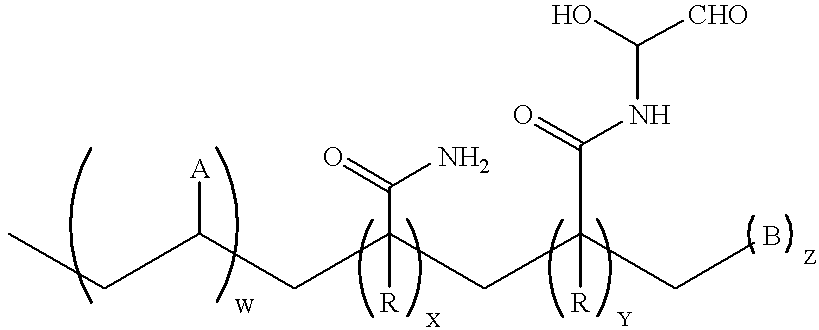Printed, soft, bulky single-ply absorbent paper having a serpentine configuration and low sidedness and methods for its manufacture
a single-ply absorbent paper, soft technology, applied in the direction of patterned paper, non-fibrous pulp addition, transportation and packaging, etc., can solve the problems of lack of softness, lack of perceived softness that is inimical to consumer acceptance, lack of softness, etc., to achieve excellent softness, low sidedness, and low sidedness
- Summary
- Abstract
- Description
- Claims
- Application Information
AI Technical Summary
Benefits of technology
Problems solved by technology
Method used
Image
Examples
example 1
(Samples 1-9)
Embossed, one-ply tissue substrate was printed with napkin / towel ink formulations using flexographic printing process on the pilot printing press in Milford, Ohio. Successful flexographic printing on one-ply bathroom tissue substrate was demonstrated. Prior to printing, the base sheet was embossed using the Arabesque emboss pattern shown in FIG. 3. Print equipment set-up included a 4.2 Billion Cubic Microns per in..sup.2 (BCM), 360 line / inch anilox roll and flexographic plates (AP55 Vinyl--Towel "Bear and Cupcake" print pattern and NR 850R rubber--napkin "Bordelaise" print pattern) mounted on 22" repeat, directly. One-ply embossed tissue substrates were successfully printed in a variety of ink colors. Table 1 shows the specific inks and ink dilutions that were used for each sample. FIGS. 1 and 2 show the "Bear and Cupcake" and "Bordelaise" print patterns, respectively. FIG. 3 shows the "Arabesque" emboss.
example 2
(Samples 10-12)
Unembossed, one-ply bathroom tissue was printed on the pilot press in Milford, Ohio, using the rotogravure process in combination with the QNBT.TM. "Rose" pattern print shown in FIG. 4. Successful rotogravure printing on one-ply bathroom tissue was demonstrated. The tissue base sheet has a furnish blend of 10% Northern Softwood, 40% Southern Hardwood, and 50% Green Bay Secondary fiber. The physical porperties of the base sheet used in Example 2 are shown in Table 2. Printing ink information for Example 2 is listed in Table 3.
TABLE 2
example 3
Samples 13-20
Unembossed, one-ply tissue substrates were successfully printed on the pilot press using the rotogravure process in combination with the QNBT.TM. "Rose" pattern print cylinder. The focus of the printing portion of this example was to ascertain whether our novel process and product would encounter common printing problems relative to one-ply substrate, namely ink migration through the sheet, ink buildup on the impression roll, plugging of the gravure roll engraving, and overall print quality. The printed base sheet was later successfully embossed on NTC CL#5 using mated micro-macro (M3), steel to steel and Double Hearts, rubber to steel embossing. The primary focus of the embossing portion of this example was to ascertain that printed one-ply tissue substrate can be successfully embossed without incurring emboss process problems such as printed areas of the substrate sticking to the emboss rolls, resulting in plugged emboss elements or wrapping of the sheet around the em...
PUM
| Property | Measurement | Unit |
|---|---|---|
| Fraction | aaaaa | aaaaa |
| Area | aaaaa | aaaaa |
| Dimensionless property | aaaaa | aaaaa |
Abstract
Description
Claims
Application Information
 Login to View More
Login to View More - R&D
- Intellectual Property
- Life Sciences
- Materials
- Tech Scout
- Unparalleled Data Quality
- Higher Quality Content
- 60% Fewer Hallucinations
Browse by: Latest US Patents, China's latest patents, Technical Efficacy Thesaurus, Application Domain, Technology Topic, Popular Technical Reports.
© 2025 PatSnap. All rights reserved.Legal|Privacy policy|Modern Slavery Act Transparency Statement|Sitemap|About US| Contact US: help@patsnap.com



